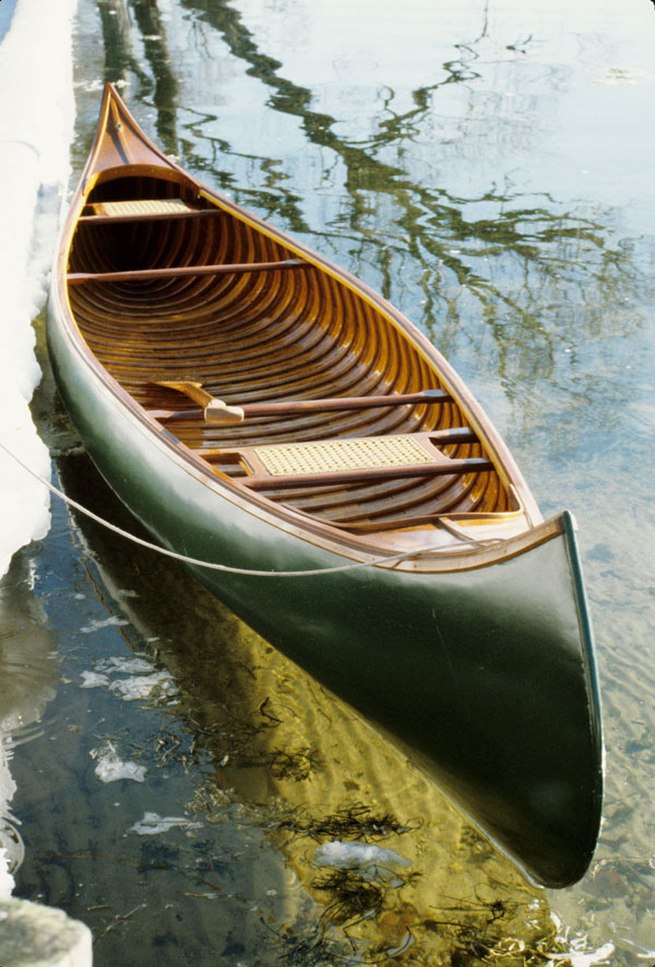-
Canoe
A canoe is a lightweight narrow vessel, typically pointed at both ends and open on top, propelled by one or more seated or kneeling paddlers facing the direction of travel using a single-bladed paddle.In British English, the term “canoe” can also refer to a kayak, while canoes are then called Canadian canoes to distinguish them from kayaks.
Canoes are widely used for competition and pleasure, such as racing, whitewater, touring and camping, freestyle, and general recreation. Canoeing has been part of the Olympics since 1936. The intended use of the canoe dictates its hull shape and length and construction material. Historically, canoes were dugouts or made of bark on a wood frame, but construction materials evolved to canvas on a wood frame, then to aluminum. Most modern canoes are made of molded plastic or composites such as fiberglass.
Canoes were developed by cultures all over the world, including some designed for use with sails or outriggers. Until the mid-1800s the canoe was an important means of transport for exploration and trade, and in some places it still is used as such, perhaps with the addition of an outboard motor. Where the canoe played a key role in history, such as the northern United States, Canada, and New Zealand, it remains an important theme in popular culture.
-
Kayak
A kayak is a small, narrow watercraft which is typically propelled by means of a double-bladed paddle. The word kayak originates from the Greenlandic word qajaq (IPA: [qajaq]).
The traditional kayak has a covered deck and one or more cockpits, each seating one paddler. The cockpit is sometimes covered by a spray deck that prevents the entry of water from waves or spray, differentiating the craft from a canoe. The spray deck makes it possible for suitably skilled kayakers to roll the kayak: that is, to capsize and right it without it filling with water or ejecting the paddler.
Some modern boats vary considerably from a traditional design but still claim the title “kayak”, for instance in eliminating the cockpit by seating the paddler on top of the boat (“sit-on-top” kayaks); having inflated air chambers surrounding the boat; replacing the single hull by twin hulls, and replacing paddles with other human-powered propulsion methods, such as foot-powered rotational propellers and “flippers”. Kayaks are also being sailed, as well as propelled by means of small electric motors, and even by outboard gas engines.
The kayak was first used by the indigenous Aleut, Inuit, Yupik and possibly Ainu hunters in subarctic regions of the world.
-
Canoe (noun)
A small long and narrow boat, propelled by one or more people (depending on the size of canoe), using single-bladed paddles. The paddlers face in the direction of travel, in either a seated position, or kneeling on the bottom of the boat. Canoes are open on top, and pointed at both ends.
-
Canoe (noun)
An oversize, usually older, luxury car.
-
Canoe (verb)
To ride or paddle a canoe.
-
Kayak (noun)
A type of small boat, covered over by a surface deck, powered by the occupant or occupants using a double-bladed paddle in a sitting position, from a hole in the surface deck
-
Kayak (verb)
To use a kayak, to travel or race in a kayak.
“Kayaking is an Olympic sport.”
-
Kayak (verb)
To traverse (a body of water) by kayak.
“On a dare, he kayaked the Harlem River in New York from Hell’s Gate to Spyten Duyvil.”
-
Kayak (noun)
a canoe of a type used originally by the Inuit, made of a light frame with a watertight covering having a small opening in the top to sit in.
-
Kayak (verb)
travel in or use a kayak
“the centre is ideal for kayaking”

